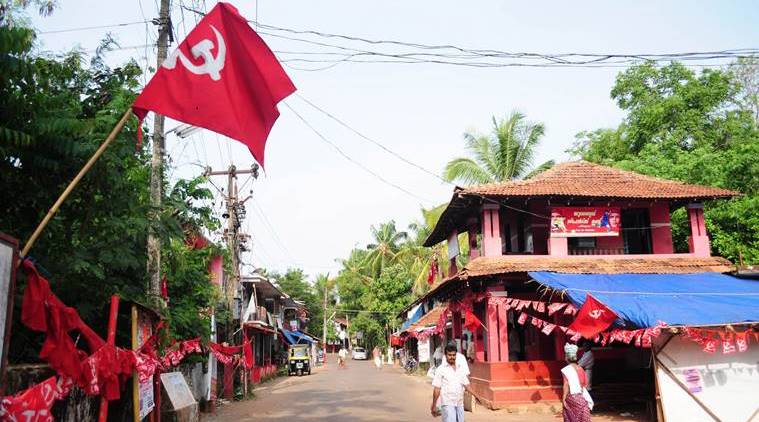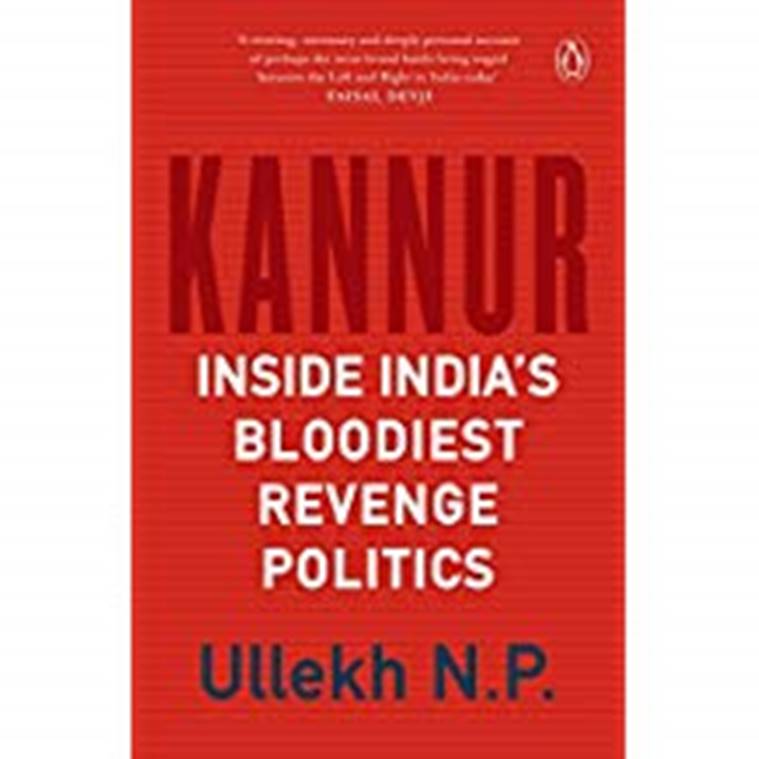Blood Will Have Blood
A well-researched, engaging book filled with sordid tales of the victims — those of the CPI(M) and the Sangh Parivar — experiences of the survivors, the trauma of the near and dear ones and interviews of some of the masterminds and behind-the-scenes operators who spread terror in the killing fields of Kannur, which Ullekh self-deprecatingly calls the “Sicily of Kerala.”

CPI(M) flags dot Parapram in Kannur. (Express photo by SK Mohan)
Kerala’s famed social advancements and its literary and cultural legacy cannot be separated from its politics. Politics, many would say, is all pervasive in the southern state; perhaps, the lifeblood of a society which has a compelling urge to argue and debate about, well, almost anything. But, in Kannur, the native district of chief minister Pinarayi Vijayan in north Kerala, politics has been more about life and blood.
As I was reading this book, a novel attempt at capturing the nature and history of the macabre and unending cycle of violence in Kannur, Malayalam television channels flashed the news of yet another killing. This time in neighbouring Kasaragod district. The blood and gore variety of politics, be it in Kannur or other parts of the state, does not evoke shock or disbelief now. There is rather a sense of weariness. One tends to agree with the author, Ullekh NP, that the continuing spree of killings, however, hurts like a migraine deep within. The son of a late Communist leader, who Vijayan looked up to as a friend and comrade, Ullekh has intimate knowledge of the politics of the CPM and the Left. Born and having grown up in Kannur, he also understands the psyche of its people.
Given that, he is better placed to undertake the tricky task of chronicling the murders and to trace the roots of the deadly war of mutual annihilation as well as the spiral of revenge politics between the Congress and the CPM in the immediate decades after independence and now between the Sangh Parivar and the CPM. The common factor, one has to say, is the CPM.
It is a well-researched, engaging book filled with sordid tales of the victims — those of the Communist Party of India (Marxist) and the Sangh Parivar — experiences of the survivors, the trauma of the near and dear ones and interviews of some of the masterminds and behind-the-scene operators who spread terror in the killing fields of Kannur, which Ullekh self-deprecatingly calls the “Sicily of Kerala.”
Ullekh has tried to lay the blame for the revenge killings on the political masters from both the CPM and the BJP/RSS, but his inherent admiration for the Communist movement and its leaders from Kannur, whom he has known since childhood, romanticises the evolution of the Party in Kerala and marks a reluctance to give equal credence to the theories propounded and arguments advanced by the RSS/BJP.
For instance, he talks about the killings and counter killings that Kannur had witnessed in the immediate decades after Independence between the Congress and the CPM. The Congress then had an upper hand and the CPM used violence as a form of resistance, he says. In fact, he quotes one of his aunts as having told him that the CPM was built in Kannur using “brute resistance.”
“But, having attained a certain kind of dominance for itself, the communist party in Kerala of the Nineties had no business in indulging in violence for its own sake or to bully opponents. The era of resistance was over,” he says. The author, however, does not take such a revolutionary view of the violence perpetrated by the BJP/RSS, although the Sangh Parivar finds itself in the CPM’s shoes now, with the Left party being the dominant force in the region.
The book is brimming with quotes, anecdotes and sketches of CPM leaders — from the venerated P Krishna Pillai and AK Gopalan to Vijayan and Kannur strongman P Jayarajan and late Communist veteran-turned-rebel MV Raghavan, better known as MVR. There is not much mention though about KG Mara, one of the Sangh’s stalwart leaders from Kannur.
He virtually holds MVR responsible for much of the blood-letting. Raghavan, he says, had been a symbol of Kannur’s murderous politics. Resistance had given way to sheer violence, he quotes a retired police officer as saying in this context. Ullekh, perhaps, is right when he says that the revenge killings — which he says is perversely called goal scoring — resembles a mafia-like operation where, if you don’t avenge the killing of a gang member, you are immediately treated as a non-entity.
Early on, he argues that unlike in southern Kerala, where caste-based movements churned the social fabric of the region, in Malabar and especially in Kannur, social change, triggered primarily by peasant uprisings, resulted in a deep wedge along political lines. Unlike in the southern parts of the state, where there was a symbiotic relationship between the caste outfits and parties, in places like Kannur, political affiliation became the new identity.
Interestingly, the book also mentions theories, risible and imaginative, discussed in the context of the culture of revenge killings in Kannur. One is the cult of Chekavars — trained in the martial art of Kalaripayattu and “readied for engaging in angams meant to uphold the honour of their princelings or wealthy local kings” in another century — who waged duels and killed or got killed even for frivolous reasons. He says “while a large section of pundits dismiss the linkage between the traditional past and the spree of violence today, statistics show that even in Kannur, it is areas that were once mentioned in the Northern Ballads that have seen disproportionately high levels of bloodbath.” That same retired top police officer is quoted as saying that the roots of violence in Kannur lie in the existence of a martial culture in the ancient past.
The author talks at length about the “Redtrocity” campaign of the Sangh, which had caught national attention and may have triggered the idea of penning such a book. He concludes by offering solutions like staging a Kalaripayattu Premier League which could galvanise young men, generate employment, convert testosterone-driven aggression into a multi-crore industry and offering leadership roles to women and peaceniks to counter the toxic masculinity in Kannur’s politics.
While all these imaginative ideas can be of some help, the cycle of violence can end only if the political masters sitting in air-conditioned rooms elsewhere stop exploiting jobless youngsters for their political advantage in the name of ideology. The CPM, being the dominant force in the region, will have a larger responsibility.






















 Kannur: Inside India’s Bloodiest Revenge Politics by Ullekh NP
Kannur: Inside India’s Bloodiest Revenge Politics by Ullekh NP
No hay comentarios:
Publicar un comentario